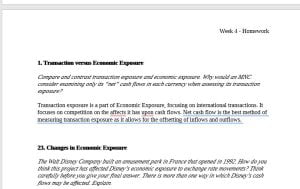Course
FIN 565 International Finance
- Question: Sources of Supplies and Exposure to Exchange Rate Risk Laguna Co.(aS. firm) will be receiving 4 million British pounds in one year. It will need to make a payment of 3 million Polish zloty in one year. It has no other exchange rate risk at this time. However, it needs to buy supplies and can purchase them from Switzerland, Hong Kong, Canada, or Ecuador. Another alternative is that it could also purchase one-fourth of the supplies from each of the four countries mentioned in the previous sentence.
- Question: Which alternative should Laguna Co. select in order to minimize its overall exchange rate risk?
- Question: Financing to Reduce Exchange Rate Exposure Nashville Co. presently incurs costs of about 12 million Australian dollars (A$) per year for research and development expenses in Australia. It sells the products that are designed each year, and all of the products sold each year are invoiced in U.S. dollars. Nashville anticipates revenue of about $20 million per year, and about half of the revenue will be from sales to customers in Australia. The Australian dollar is presently valued at $1 (1 S. dollar), but it fluctuates a lot over time. Nashville Co. is planning a new project that will expand its sales to other regions within the United States, and the sales will be invoiced in dollars. Nashville can finance this project with a five-year loan by (1) borrowing only Australian dollars, (2) borrowing only U.S. dollars, or (3) borrowing one-half of the funds from each of these sources. The five-year interest rates on an Australian dollar loan and a U.S. dollar loan are the same. 1. If Nashville wants to use the form of financing that will reduce its exposure to exchange rate risk the most, what is the optimal form of financing? 2. Now assume that Nashville expects … Suppose the company wants to maximize its expected net present value of its new project and is not concerned about its exposure to exchange rate risk. Under these conditions, which financing alternative is most appropriate? Briefly explain.
- Question: Hedging with Forward Contracts Explain how a U.S. corporation could hedge net receivables in Malaysian ringgit with a forward contract. Explain how a U.S. corporation could hedge payables in Canadian dollars with a forward contract.
- Question: Forward versus Options Hedge on Payables If you are a U.S. importer of Mexican goods and you believe that today’s forward rate of the peso is a very accurate estimate of the futures pot rate, do you think Mexican peso call options would be a more appropriate hedge than the forward hedge? Explain.
- Question: Forward versus Options Hedge on Receivables You are an exporter of goods to the United Kingdom, and you believe that today’s forward rate of the British pound substantially underestimates the future spot rate. Company policy requires you to hedge your British pound receivables in some Would a forward hedge or a put option hedge be more appropriate? Explain.
- Question: Limitations of Hedging Translation Exposure Bartunek Co. is a U.S.-based MNC that has European subsidiaries and wants to hedge its translation exposure to fluctuations in the euro’s value. Explain some limitations when it hedges translation exposure.
ANSWER

…..please click the icon below to purchase the answer at $10